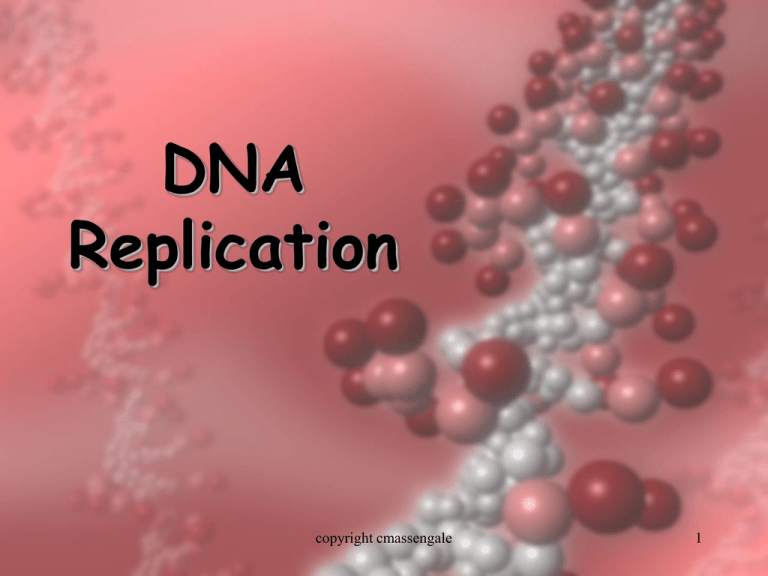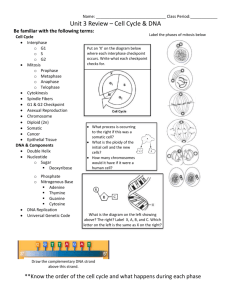
DNA
Replication
copyright cmassengale
1
Replication Facts
• DNA has to be copied
before a cell divides
• DNA is copied during the S
or synthesis phase of
interphase
• New cells will need identical
DNA strands
copyright cmassengale
2
Synthesis Phase (S phase)
• S phase during interphase of the
cell cycle
• Nucleus of eukaryotes
S
DNA replication takes
place in the S phase.
phase
G1
interphase
G2
Mitosis
copyright cmassengale
-prophase
-metaphase
-anaphase
-telophase
3
DNA Replication
• DNA must be copied in order for cell
reproduction
• The DNA molecule produces 2
IDENTICAL new complementary
strands following the rules of base
pairing:
•Each strand of
the original
DNA serves as
a template for
the new strand
A-T, G-C
DNA Replication
Step One - DNA Helicase – Travels down
the DNA molecule and “unzips” it by
breaking hydrogen bonds between base pairs.
The Y-shaped junction of the unwound
molecules is a replication fork.
.
DNA Replication
•
•
Step Two: DNA polymerase can
then add the new nucleotides
to form a new strand of
complimentary DNA attached
to the split apart strand
DNA polymerase can only travel
down DNA is a 5’ to 3’
direction, creating a leading
strand of DNA and lagging
strand
6
Remember DNA Strands are Antiparallel – So both
DNA Polymerases will be travel in opposite directions
5
while adding nucleotides,
one will have an easy
path, the other will have
to travel backwards.
O
3
P
5
O
C
G
1
3
O
P
5
3
2
4
4
P
5
P
2
3
1
O
T
A
3
O
3
5
O
copyright cmassengale
5
P
P7
DNA Replication
Copyright Pearson Prentice Hall
Synthesis of DNA Strands
• The Leading Strand is synthesized
as a single strand from the point
of origin toward the opening
replication fork, it only needs DNA
Polymerase to add nucleotides. This
is the easy path.
5’
3’
5’
Nucleotides
DNA Polymerase
copyright cmassengale
9
Synthesis of the New DNA
• The Lagging Strand is
synthesized in chunks, not
smoothly like the leading
strand, against overall
direction of replication
• This strand is made in MANY
short segments
5’
3’
3’
5’
Lagging Strand
copyright cmassengale
10
Lagging Strand Segments
• Okazaki Fragments - series of
short segments on the lagging
strand
• Must be joined together by an
enzyme
DNA
Okazaki Fragment
RNA
Primer
5’
3’
Polymerase
3’
5’
Lagging Strand
copyright cmassengale
11
copyright cmassengale
12
DNA Lagging Strand
• Before new DNA strands can
form on the lagging strand, there
must be RNA primers present
RNA Primase is the enzyme that
synthesizes the RNA Primers –
gives DNA polymerase a path to
follow
• After, DNA polymerase adds
nucleotides to the lagging strand
just like the in the leading
strand copyright cmassengale
13
Third Step:
• The enzyme DNA Ligase joins
the leading strand nucleotides or
Okazaki fragments together to
make one strand
DNA ligase
5’
3’
Okazaki Fragment 1
Okazaki Fragment 2
3’
5’
Lagging Strand
copyright cmassengale
14
DNA Replication
• Semiconservative Model:
• From Watson and Crick
• New DNA consists of 1
PARENTAL (original) and 1
NEW strand of DNA
DNA Template
Parental DNA
New DNA
Short video on
Replication
• https://www.youtube.com/watch
?v=JZXT2uOcD2w
copyright cmassengale
17




